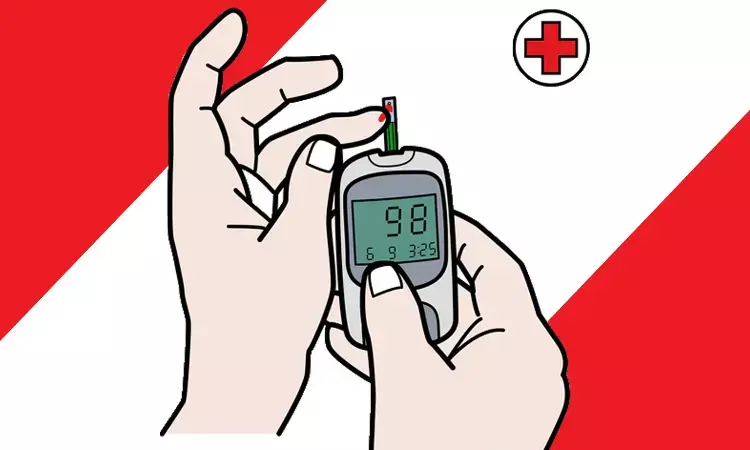- Home
- Medical news & Guidelines
- Anesthesiology
- Cardiology and CTVS
- Critical Care
- Dentistry
- Dermatology
- Diabetes and Endocrinology
- ENT
- Gastroenterology
- Medicine
- Nephrology
- Neurology
- Obstretics-Gynaecology
- Oncology
- Ophthalmology
- Orthopaedics
- Pediatrics-Neonatology
- Psychiatry
- Pulmonology
- Radiology
- Surgery
- Urology
- Laboratory Medicine
- Diet
- Nursing
- Paramedical
- Physiotherapy
- Health news
- Fact Check
- Bone Health Fact Check
- Brain Health Fact Check
- Cancer Related Fact Check
- Child Care Fact Check
- Dental and oral health fact check
- Diabetes and metabolic health fact check
- Diet and Nutrition Fact Check
- Eye and ENT Care Fact Check
- Fitness fact check
- Gut health fact check
- Heart health fact check
- Kidney health fact check
- Medical education fact check
- Men's health fact check
- Respiratory fact check
- Skin and hair care fact check
- Vaccine and Immunization fact check
- Women's health fact check
- AYUSH
- State News
- Andaman and Nicobar Islands
- Andhra Pradesh
- Arunachal Pradesh
- Assam
- Bihar
- Chandigarh
- Chattisgarh
- Dadra and Nagar Haveli
- Daman and Diu
- Delhi
- Goa
- Gujarat
- Haryana
- Himachal Pradesh
- Jammu & Kashmir
- Jharkhand
- Karnataka
- Kerala
- Ladakh
- Lakshadweep
- Madhya Pradesh
- Maharashtra
- Manipur
- Meghalaya
- Mizoram
- Nagaland
- Odisha
- Puducherry
- Punjab
- Rajasthan
- Sikkim
- Tamil Nadu
- Telangana
- Tripura
- Uttar Pradesh
- Uttrakhand
- West Bengal
- Medical Education
- Industry
Patients of type I and type 2 Diabetes at increased risk of falls: Study

Nicklas Rasmussen at Steno Diabetes Center and North Jutland Aalborg University Hospital, Aalborg, Denmark, and colleagues have found in a new research that having type 1 diabetes (T1D) is associated with a 33% increase in the risk of falls compared with the general population, while having type 2 diabetes (T2D) is associated with a 19% increased risk of falls. The study is being presented at this year's annual meeting of the European Association for the Study of Diabetes (EASD), held online this year (21-25 September).
People with diabetes can be at increased risk of falls as they tend to have more complications (for example high and low blood sugar), and use of medication compared with the general population without diabetes. This study aimed to estimate the risk of falls and to identify risk factors associated with increased falls in people with diabetes compared with the general population. The second aim was to estimate fall-related injuries including fractures and where in the body these fractures are occurring compared with the general population.
From the Nationwide Danish National Patient Register the authors identified 12,975 people with T1D and 407,099 people with T2D and a sex- and age-matched control group (1:1) from the general population. All episodes of people hospitalised with a first fall from 1996 to 2017 were analysed using computer modelling. Risk factors such as age, sex, diabetic complications, a history of alcohol abuse and a history of medication were included in an adjusted analysis. The incidence rates, incidence rate differences and incidence rate ratios of falls and the location in the body of fall-related injuries and fractures were calculated.
In the adjusted analysis T1D was associated with 33% increased risk of a first fall, and T2D a 19% increased risk. The cumulative incidence, of falls requiring hospital treatment was 13% in T1D, and 12% in T2D.
For patients with T2D, other risk factors for falls were: being female (60% increased risk), being aged over 65 years (32%), use of selective serotonin receptor inhibitors (SSRIs) (used to treat depression) (32%), use of opioids (9%), SSRIs and opioids combined (60%), and a history of alcohol abuse (a near doubling of risk).
For patients with T1D, other risk factors identified for falls were: being female (20 % increased risk) aged over 65 years (30%), use of SSRIs (35%), use of opioids (15%) and a history of alcohol abuse (77%).
Increased incidence of fractures was also identified in people with T2D. Compared with the general population, there was increased risk of fractures of the hip and femur (2%), humerus (the long arm bone) (24%), radius (forearm bone) (39%) and skull/face (15%). People with T1D also had an increased risk of fractures, but only at the hip and femoral region (11%).
The authors say: "While of course we cannot do anything about getting older or our gender, diabetes - especially type 2 diabetes - use of medications and alcohol abuse could be potentially modifiable risk factors for falls. Gaining further information on risk factors for falls could guide the management of diabetes treatment such as the choice of medication, which enables us to improve treatment particularly in people with a high risk of falls and fractures associated with high mortality."
Hina Zahid Joined Medical Dialogue in 2017 with a passion to work as a Reporter. She coordinates with various national and international journals and association and covers all the stories related to Medical guidelines, Medical Journals, rare medical surgeries as well as all the updates in the medical field. Email: editorial@medicaldialogues.in. Contact no. 011-43720751
Dr Kamal Kant Kohli-MBBS, DTCD- a chest specialist with more than 30 years of practice and a flair for writing clinical articles, Dr Kamal Kant Kohli joined Medical Dialogues as a Chief Editor of Medical News. Besides writing articles, as an editor, he proofreads and verifies all the medical content published on Medical Dialogues including those coming from journals, studies,medical conferences,guidelines etc. Email: drkohli@medicaldialogues.in. Contact no. 011-43720751


